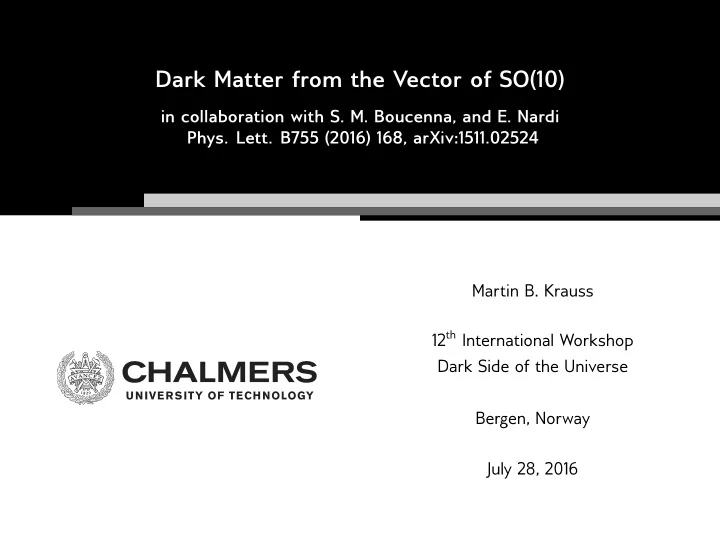

Dark Matter from the Vector of SO(10) in collaboration with S. M. Boucenna, and E. Nardi Phys. Lett. B755 (2016) 168, arXiv:1511.02524 Martin B. Krauss Dark Side of the Universe Bergen, Norway July 28, 2016 12 th International Workshop
Motivation Colorless , electrically neutral and weakly interacting particles in the GeV-TeV range well suited to reproduce DM energy density if stable on cosmological timescales . Enforcing DM staibility: Breaking GUT symmetries unifjcation and proton stability, free from gauge anomalies. 1 / 11 � R-Parity (SUSY) � Kaluza-Klein Parity � T-parity (littlest Higgs) � Z 2 , in scotogenic model, inert doublet model, etc. → remnant unbroken Z 2 parity SO (10) unifjes SM fermions with N R into 16 irrep., allows for gauge coupling
[Kibble, Lazarides, Shafj (1982)] Fermions: Bosons: see, e.g., [Kadastik, Kannike, Raidal (2009); Kadastik, Kannike, Raidal (2010)] [Frigerio, Hambye (2010)] [Mambrini, Nagata, Olive, Quevillon, Zheng (2015); Nagata, Olive, Zheng (2015)] 2 / 11 The SO (10) framework I Breaking SO (10) exclusively with vev in tensor representations → unbroken Z 2 remains Stable particles in SO (10) representations 10 , 45 , 54 , 120 , 126 , 210 , 210 ′ , 16 , 144 . So far, special attention to 16 and 45 → contain SM singlets (no DD) Here: DM in fermionic 10
3 / 11 SO(10) breaking: SO (10) framework II � 45 H � SO (10) − → 3 C 2 L 2 R 1 B − L � 126 � − → 3 C 2 L 1 Y ⊗ Z 2 � 10 H � − → 3 C 1 Q ⊗ Z 2 DM in SU (2) L ⊗ SU (2) R bidoublet: � � ξ + − ξ ++ L , R L , R ξ L , R = ξ −− ξ − + L , R L , R
Dark Matter mass Two possible Dirac mass terms: In our model: 4 / 11 � m b ∝ � 45 � , conserves L-R symmetry � δ m , transforms as � 54 � , breaks L-R and EW symmetries m b ξ + − ξ + − L R (0 , 0) δ m ξ + − ξ − + L ( − 1 , + 1) R No 54 , but DM couples to Higgs bidoublet via loop ( 10 × 10 ⊃ 54 )
Mass splitting 5 / 11 Loop induced mass-splitting δ m ∝ v u v d m b M 2 W R � ϕ − + � � ϕ + − � W − 1 , 0 W 0 , − 1 L R ξ −− ξ −− L R ξ + − ξ − + m b L R ⇒ Two non-degenerate Dirac fermions χ l and χ h with mass m h,l = m b ± δ m
Direct detection constraints TeV 6 / 11 Couplings of χ l,h to neutral gauge bosons off-diagonal : Vectorlike neutral current µ = 1 2 χ h γ µ χ l + h . c . J nc Mass splitting 2 δ m between the light and heavy neutral state, χ l and χ h is � 200 keV ⇒ DD is kinematically suppressed. Large enough splitting → upper bound on M W R � m b � 1/2 M W R � 25 1 TeV
Relic Density I Mass splittings irrelevant for DM relic density: c.f. Minimal Dark Matter [Cirelli, Fornengo, Strumia (2006)] 7 / 11 → Assume two degenerate SU (2) L doublets at thermal freeze-out Relic density � 2 � m DM Ω DM h 2 ≈ 0 . 1 1 2 · 1 . 1 TeV √ � Annihilation via Z L → correct relic density for m b = 0 . 77 TeV � Additional resonant annihilation via W R and Z R
Relic Density II 8 / 11
DM searches Indirect Detection Collider Searches 9 / 11 � No diagonal coupling to Z L,R � Leading annihilation channel into W L W L and Z L Z L (via t-channel exchange of χ ± and χ h ) χ l → W L W L we can estimate � σ W | v |� ∼ 3 × 10 − 28 (2 TeV / m l ) 2 cm 3 / s � For χ l ¯ � Even with non-relativistic Sommerfeld corrections well below current limits ( � σ W | v |� � (10 − 25 − 10 − 24 ) cm 3 / s for the mass range 1 TeV < m l < 4 TeV ) � Most sensitive searches from monojet searches ( pp → χ a χ b j ) � Large background from Z, W + jets � Searches for quasi-degenerate Higgsino-like DM → reach of m l ∼ 250 GeV ( relic density ⇒ m l ∼ 0 . 77 TeV )
Asymmetric component (c.f. Minimal Asymmetric Dark Matter [Boucenna, MBK, Nardi (2015)]) HERE: 10 / 11 � DM carries hypercharge → can distinguish particles from anti-particles � χ in chemical equilibrium with SM particles → acquires asymmetry � Asymmetric contribution to relic density signifjcant? � In the MADM SU (2) L doublet asymmetry negligible � Tree-level asymmetry transfer via W R � Resonant annihilation of symmetric component � … Still small asymmetric contribution expected, maybe except close to Z R resonance.
11 / 11 Summary & Conclusions � Remnant Z 2 from SO (10) breaking stabilizes DM � Minimal scalar sector 45 + 126 + 10 � DM in minimal 10 irrep. viable � Mass-splitting via loop with W R � Light stable Dirac fermion χ l as DM � Non-diagonal coupling to Z L → evades DD � Upper limit on M W R
Recommend
More recommend